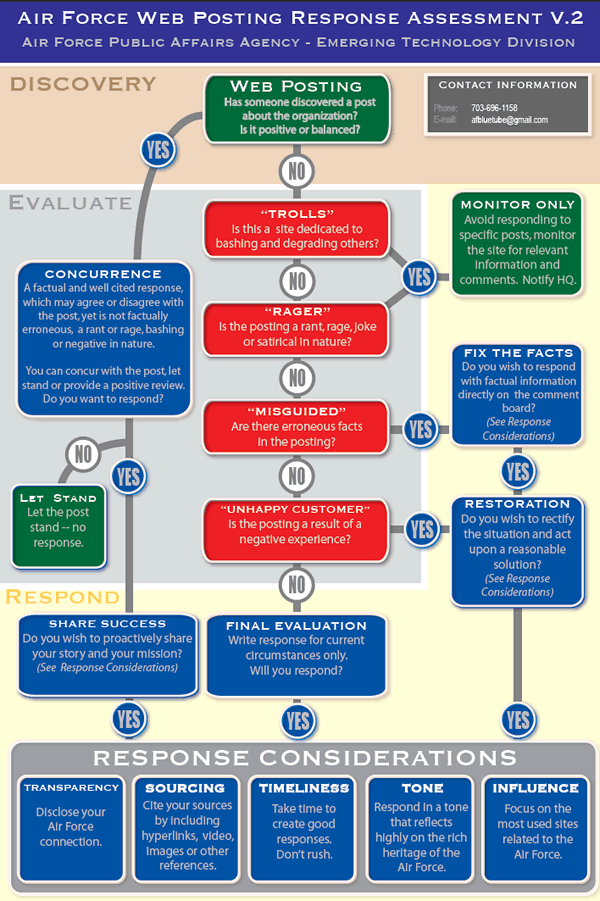
One of the biggest fears in dealing with social media (especially on a service as public as Twitter) is how to deal with inevitable negative comments about you or your brand. There’s a right and wrong way to deal with it. Replying immediately to your detractor may not always be the best solution – in fact it rarely is. You must maintain a position of strength and honor whenever dealing with criticism. This may not always be possible, but it is always possible to make the problem worse by handling it incorrectly. The Air Force Web Posting Response Assessment is a great reference.
When a negative tweet (or blog comment, etc.) is posted there are several steps to follow and questions to ask yourself:
How Bad is it, Really?
This is a subjective measure of how important the message is in context. Are they joking? Being amusing? Using satire? If so, is it worth responding? Or are they angry or raging? Has a product failed in the field? Have they lost money (and time is money) because of it? Have they had a terrible support experience with your brand? Do they simply dislike you? With popularity and readership come trolls - you may just want to let them pass.
Identify the user
If the message is deemed important enough to respond, then go to their blog/Facebook/Twitter profile and review their latest content manually or by using some of the countless free tools provided on the Web. Tweetstats and Twitalyzer are great for Twitter. Use Google or LinkedIn to get a quick feel for their background. If they have a blog, glance through the topics of their posts. This should not take long – 10 minutes is plenty. You just want to get a sense of who they are to give you an idea of what type of person you are dealing with. Are they a decision maker? An influencer? Or just trying to stir up trouble to get noticed?
If the comment came from Twitter, follow them on Twitter
If you are not already following them, do so. This allows you to open the possibility of private direct-message (DM) communication with them. The idea is to get them off the public time line (the public stream everyone sees in Twitter) and into a one-on-one conversation to mitigate the damage they could cause.
Resist the hasty reply – seriously, just calm down
The gut feeling is to defend immediately and publicly. Perhaps via a public @reply on Twitter if that's where the comment originated (which would be your only option if there is not a mutual follower relationship which allows DMs.) On Twitter especially, quick reactions can be seen as defensive actions, especially for brands. Competitors will be watching. Usually what the person wants is an audience or a soapbox. Do NOT reply defensively. If they already have a bad impression of your brand or are angry, replying immediately and defensively will just amplify their feelings. Remember they don’t know you, and you don’t know them. Rapid replies may literally make them feel like you are stalking them (especially in cases where they’ve already dealt with your support organization and are venting frustration!) They’ve spent hours on the phone with your company with no result and suddenly with one message they have the brand at their feet? Take time to come up with an appropriate response. Remember that all public responses will be seen by all of your followers as well! Don’t get caught with your foot in your mouth or pie on your face. The same logic applies to other venues: blog comments, Facebook status comments, etc.
Play nice and come up with a ‘remarkable’ response
Even if you are completely convinced the person hasn’t a clue what they are talking about make sure you treat them with dignity, respect, and courtesy. Treat it as a golden opportunity to reinforce the dominance of your customer satisfaction (or your genuine humanity if it’s You.) On Twitter, apologize publicly then ask them to DM you to explain the problem. Once you are in DM contact, listen to their problem and make sure their issues are addressed, if possible. DO NOT send them through the same channels your Web site would. Get them to someone that can make decisions and help them. Work with whatever resources at your disposal to come up with an appropriate response if time allows. But you should not wait longer than a few hours to reply. Make sure that response is not only good, it’s remarkable. You want them to not only be happy: you want them to relay the experience to others if possible.
If others are involved, find, follow, and research them as well
Sometimes a problem grows quickly or many are involved to begin with. Make sure you follow and research all the friends of the original sender if they are part of the conversation. Many times these people will become brand advocates if they feel you have handled a situation well and help to alleviate the problem for you.
No matter the outcome, be gracious
Thank them for contacting you. Be sincere. Give them something free if you can (or are in a business that has product at all) for their trouble. Make sure they realize and come away with the feeling that you gave it your all to make them happy, even if the outcome does not make them so. Sometimes, you cannot. Products have bugs, hardware has failures, calls get dropped, stuff happens. But most of the time people just want to know you care enough to help them or listen. If the problem the person refers to is a known issue, ensure that you will personally follow up with them when a fix or solution is available – and do so.
Tags:
Community ManagementApril 09, 2009

